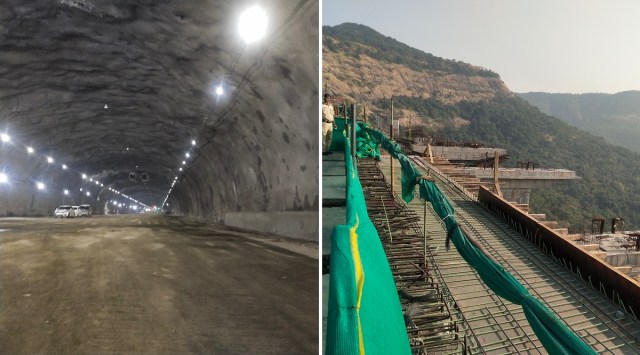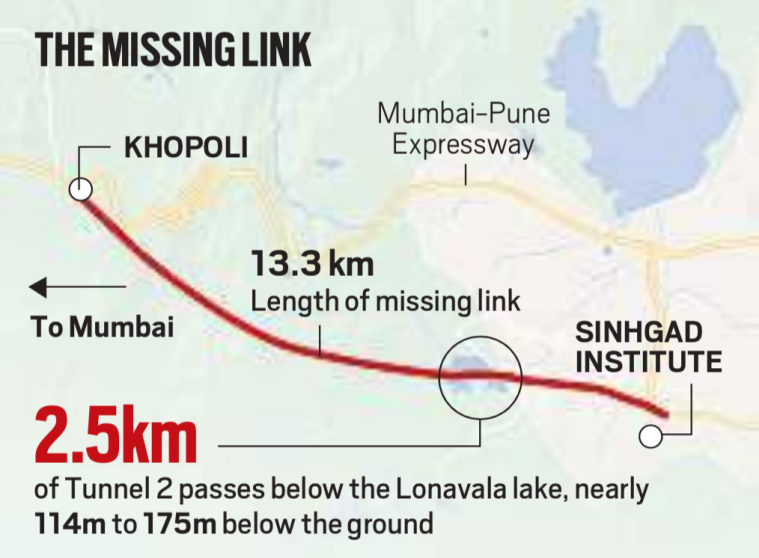Through mountains and under a lake, Mumbai to Pune via Asia’s widest road tunnels
The twin tunnels, each 24 metres wide, runs through the Sahyadri mountains and under the Lonavala lake; expected to shave off 25 min of travel time
 If all goes to plan, by January 2024, the drive from Mumbai to Pune will pass through this 'missing link'. (Express)
If all goes to plan, by January 2024, the drive from Mumbai to Pune will pass through this 'missing link'. (Express)On a weekday afternoon, men in hard hats and fluorescent reflective jackets worked to plaster the walls of the giant cavern, guided by their headlights and the string of lights on the roof. At the far end, their supervisors carried out a review of the unfinished stretch.
This is Tunnel 2 of Rs 6,600-crore ‘missing link project’ of the Mumbai-Pune Expressway, the second and the longer of two sets of twin tunnels, which, at 24 metres each, are set to be Asia’s widest.
If all goes to plan, by January 2024, the drive from Mumbai to Pune will pass through this 13.3-km-long ‘missing link’ – an engineering marvel that’s expected to decongest the six-lane Mumbai-Pune Expressway.
Currently, those traveling between the two cities take either the six-lane, 94-km-long Mumbai-Pune Expressway or the old Mumbai-Pune Highway (or National Highway No-4), a four-lane, 111-km road stretching from Shil Phata to Dehu Road. But somewhere near the Khalapur toll plaza, the traffic on both the expressways merge, leading to a bottleneck until Khandala Exit as the traffic of 10 lanes converge on six lanes of the expressway. Besides, this stretch passes through ghats and is prone to landslides during the monsoons, leading to further congestion.

Last week, Maharashtra Chief Minister Eknath Shinde visited Tunnel 2 of the ‘missing link’ project, called this because it fills a key lacunae in the existing expressway.
“This will be a landmark project in the country, as it has used modern technology which is currently used in some foreign countries. The width of the tunnel is 23.75 meters, making it the widest tunnel in the world. Measures have been taken to prevent fire incidents inside,” he said.
The Rs 6,695-crore project comprises two sets of twin tunnels, and two viaducts, one of which is a cable-stayed bridge. Sources at MSRDC said that while the tunnels are almost 90 per cent complete, the entire project is around 60 per cent ready.
Once completed, those driving from Mumbai to Pune will get on to the ‘missing link’ stretch at Khopoli, bypass the expressway and drive 840 metres on a viaduct, before entering Tunnel 1 (1.75 km long). Once out of this tunnel, vehicles will cover 640 metres on a cable-stayed viaduct bridge, before entering Tunnel 2, which is 8.9 km long. A part of this tunnel plunges around 170 feet below the ground, under the Lonavala lake, to finally emerge on the Sinhgad Institute side.
 The Rs 6,695-crore project comprises two sets of twin tunnels, and two viaducts, one of which is a cable-stayed bridge. (Express Photo)
The Rs 6,695-crore project comprises two sets of twin tunnels, and two viaducts, one of which is a cable-stayed bridge. (Express Photo)
The link is expected to shave off around 6 km of the distance between the two cities and cut travel time by 20-25 minutes.
While underground tunnels are usually 3+3 lanes (three lanes for oncoming traffic and three for downward traffic), with an average width of 12 metres, the tunnels of the ‘missing link’ have eight lanes each (4+4 lanes) along with 2.5-metre-wide emergency lanes on either side.
With the Mumbai-Pune Expressway handling nearly 60,000 vehicles a day, and the traffic increasing by an average of 12-15 per cent every year, the tunnels are expected to take some load off the stretch. “The tunnels were built keeping in mind the future traffic needs on this road stretch. We decided it is wise to build wide tunnels as it is difficult to expand them in the future,” said Rahul Vasaikar, Superintendent Project Executive Engineer of the Maharashtra State Road Development Corporation (MSRDC), the agency that’s implementing the project. “The project proposes to avoid the steep slope and the ghat section and thus make the existing expressway a zero fatality corridor.”
MSRDC engineers said the showpiece of the missing link project are the twin tunnels whose construction involved controlled blasting of the basaltic rock of the Sahyadris. Nearly 5.7 lakh truck trips were made to remove the 40 lakh cubic metres of rubble generated by the blasting process, with the waste being reused for road construction.
While boring through hard basaltic rock was tough, the engineers faced an even bigger challenge as 2.5 km of the stretch runs below the Lonavala lake – nearly 114-175 metre below the ground.
“We used the same controlled blasting method on this particular stretch below the lake as we had when we bore through the mountain. Though we were expecting some water leakage since the 2.5-km stretch is below the water body, we faced no major trouble except at a few spots. But since the tunnel will be used for, say, at least 100 years, we are doing waterproofing and chemical grouting to prevent water leakages,” said Noel P Mundo, team leader and senior tunnel engineer of GEODATA Engineering SpA, a Turin-headquartered company that is assisting MSRDC with the construction of the tunnels.
Nearly 2,000 workers are deployed for the project, of whom nearly 1,500 have been working on the tunnel alone.
While the existing Mumbai-Pune Expressway has six tunnels, the MSRDC has planned for greater safety features in the new tunnels.
Over 30 cross passages, at a distance of every 300 metres, have been featured in the twin tunnels to help people move from one tunnel to the other in case of emergencies. The tunnels are also equipped with fire-fighting systems such as sprinklers, smoke-detection alarms and quick response vehicles, among others.







